Lake Buchanan in Texas isn’t typically considered dangerous. However, like most lakes, it is home to many types of wildlife, including snakes. Below, we’ll look at the snakes you might encounter at Lake Buchanan, as well as what to do if you see one.
1. Western Diamondback Rattlesnake
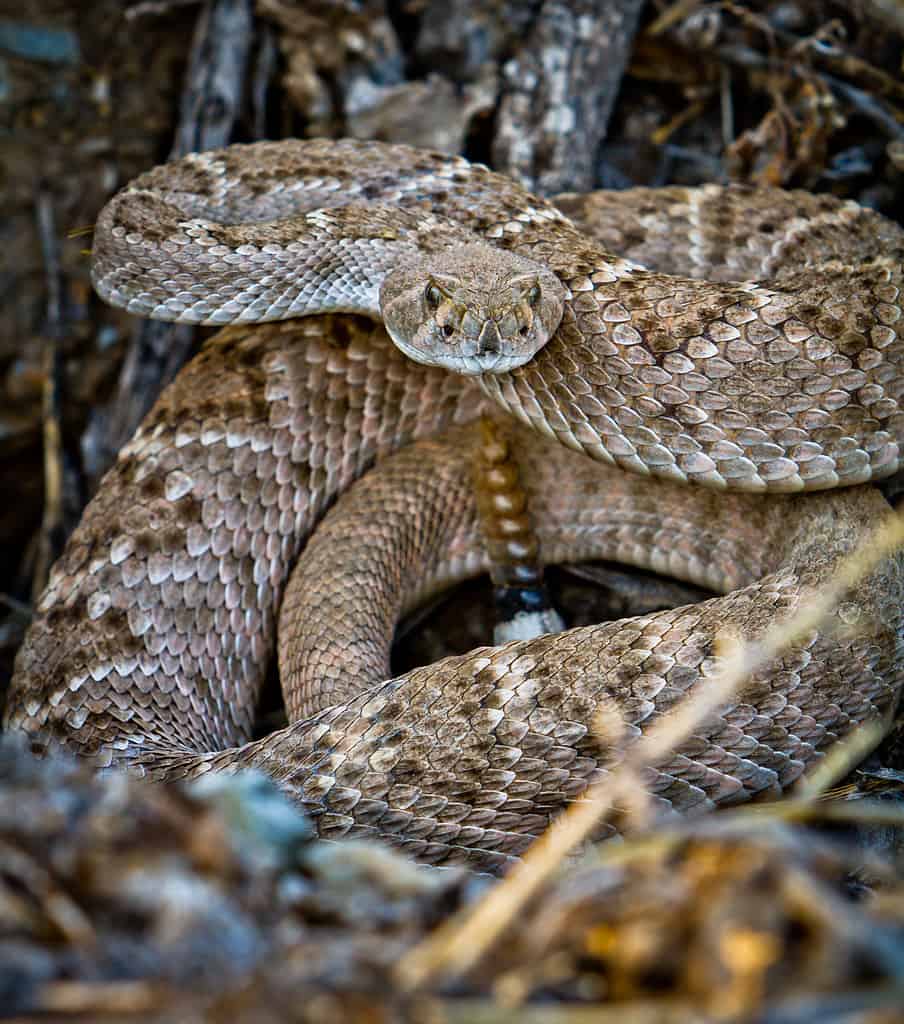
Western Diamondbacks are venomous, but they are also very skittish and tend to avoid people at all costs. Plus, their “warning system” helps prevent bites.
©PhilBilly/iStock via Getty Images
The Western Diamondback Rattlesnake is one of the few venomous snakes you may encounter around this lake. It is a formidable snake with a very large body and a distinctive diamond-shaped pattern. Because they rattle, they are pretty easy to identify. You should hear them before you see them, which warns you that you need to back up.
While rattlesnakes are venomous, they aren’t aggressive. Therefore, they will rattle and try to escape before biting, giving you plenty of opportunity to get away from it.
Their coloration varies from shades of brown to gray or even pinkish.
2. Copperhead
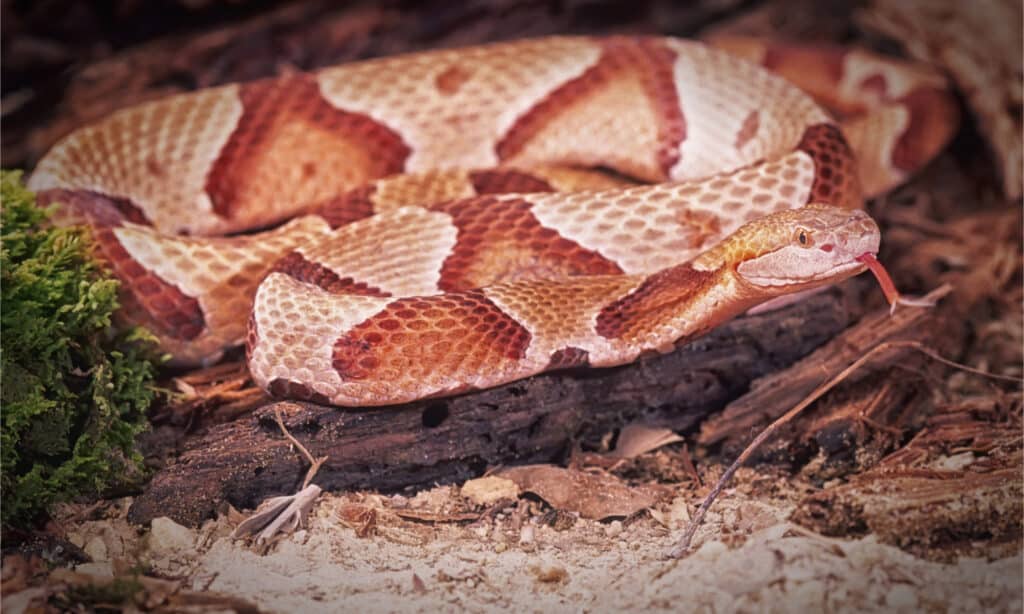
Copperheads are beautiful but venomous! Fortunately, their venom isn’t as dangerous as their cousin, the cottonmouth.
©outdoorsman/Shutterstock.com
Copperheads are another venomous snake. They’re of medium size and known for their striking appearance. As you might guess, they have copper-colored heads, which is where they got their name. Their back also has a series of hourglass-shaped bands or patterns that run down their back. You can use this pattern to help identify them.
They also have pit organs, a heat-sensing structure between their eyes and nostrils.
Usually, you’ll find these snakes in wooded or rocky habitats. Their bites are very painful, but they are rarely fatal to humans.
3. Cottonmouth
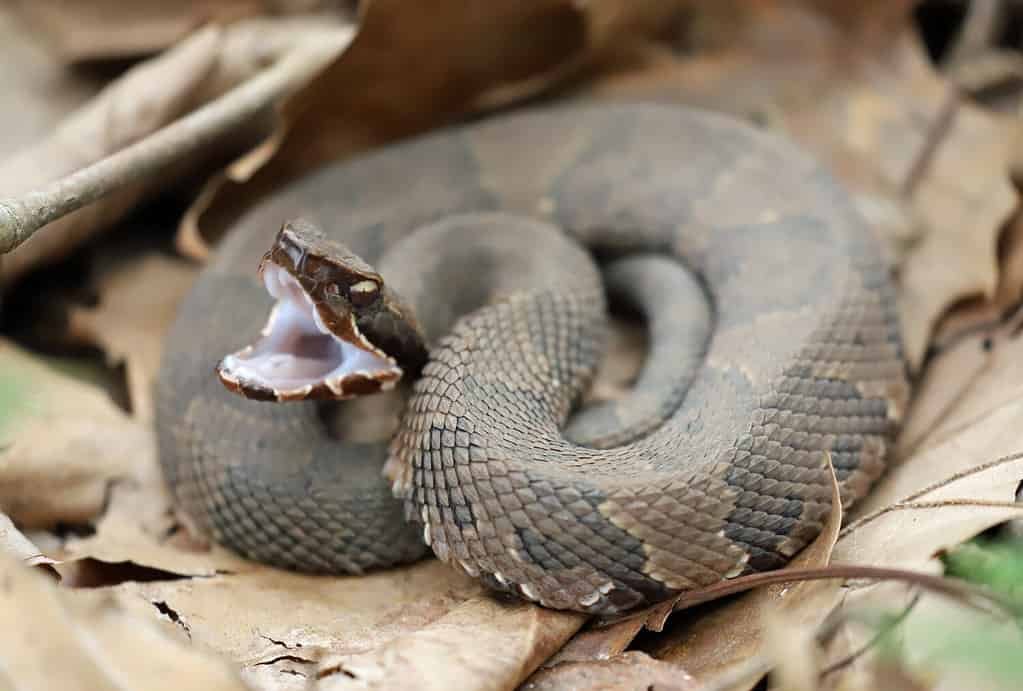
These snakes are very good at camouflage, especially around the lake. Therefore, they can be hard to spot before you’re in the “danger zone.”
©KF2017/Shutterstock.com
Cottonmouths are also venomous and may be found around this lake. They’re also called water moccasins (though some people use this term to refer to all water snakes). These robust snakes are known primarily for their dark, water-resistant scales and white mouth, which they display when threatened.
They are known for getting quite large and can come in many different colors, from brown to olive green. They blend in well with their semi-aquatic habitat in most cases. You can often find them around bodies of water like swamps and lakes, including Lake Buchanan.
4. Western Rat Snake
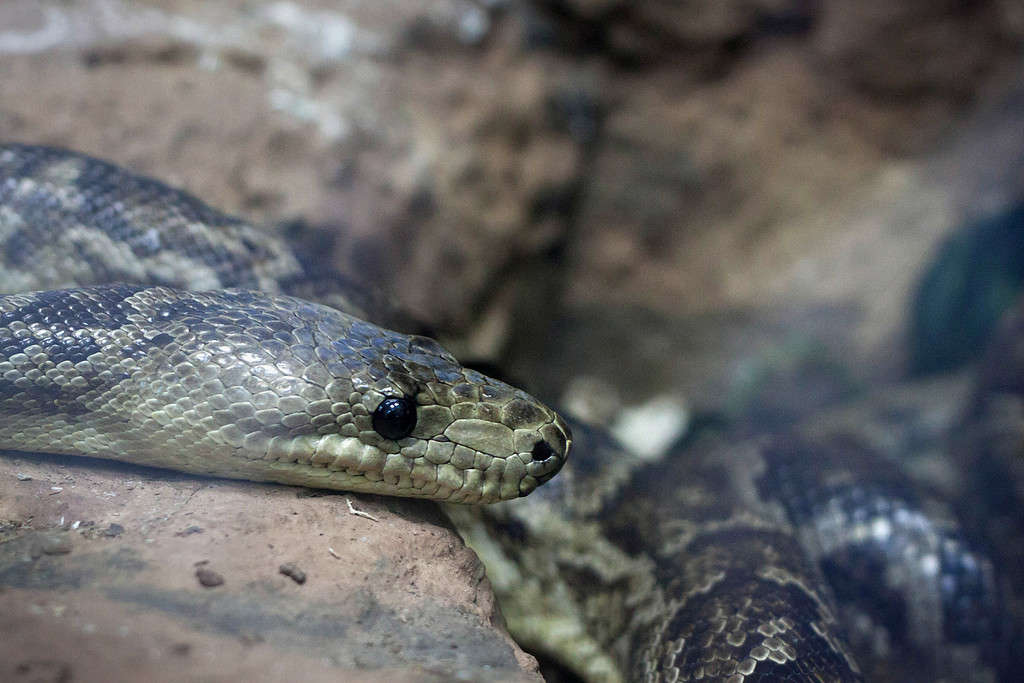
Pantherophis obsoletus (also known as the western rat snake) is not a threat to people. However, they do play a key role in controlling the rodent population.
©Kutredrig/iStock via Getty Images
The western rat snake is completely harmless to humans. It is non-venomous with a very slender body. They vary in coloration a lot, but they are usually brown or gray with dark blotches running down their backs.
Skilled climbers, these snakes often appear in trees. They’re also very adaptable, allowing them to live in a range of areas, including around lakes. They aren’t water snakes, though, so they don’t spend much time in the water.
Western rat snakes mostly eat mice and other rodents, constricting them.
5. Texas Rat Snake
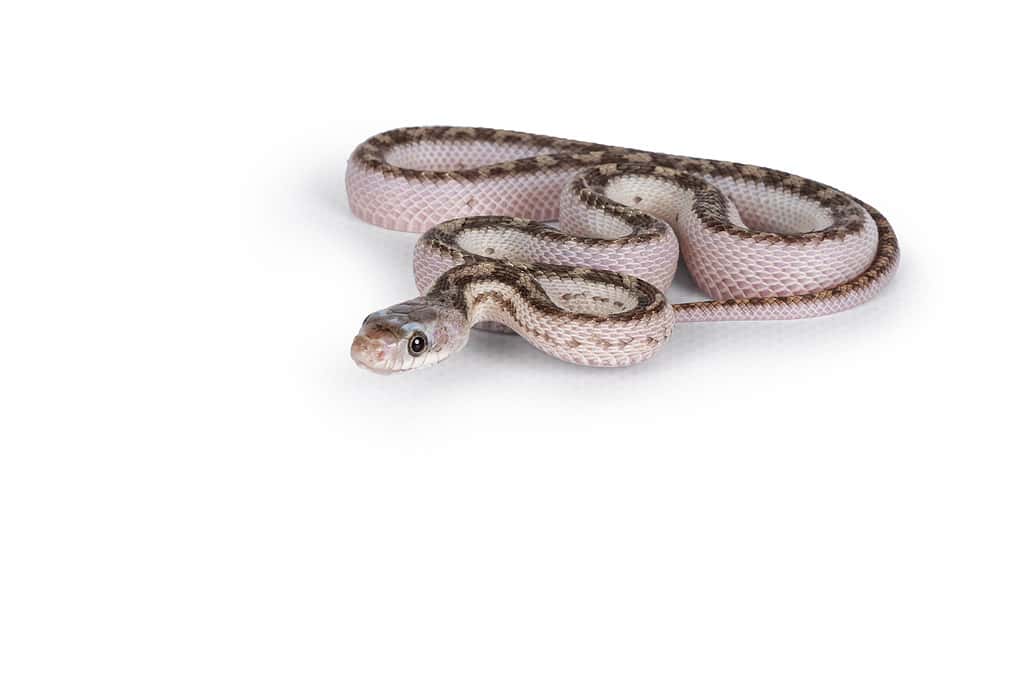
While these snakes are usually yellowish, they can come in several different color combinations. This one is a “white-sided” Texas rat snake.
©Nynke van Holten/iStock via Getty Images
This species is another non-venomous snake you may see around the lake. Texas rat snakes are large snakes with a distinctive yellowish background with dark blotches. They’re sometimes mistaken for large venomous snakes, but their coloration should help in identification.
They are agile climbers often seen near wooded areas and farmlands and, sometimes, close to water bodies. However, they’re exceptionally adaptable, so you can find them just about anywhere there is a food source.
These snakes play a vital role in the ecosystem by helping to control rodent populations.
6. Western Coachwhip
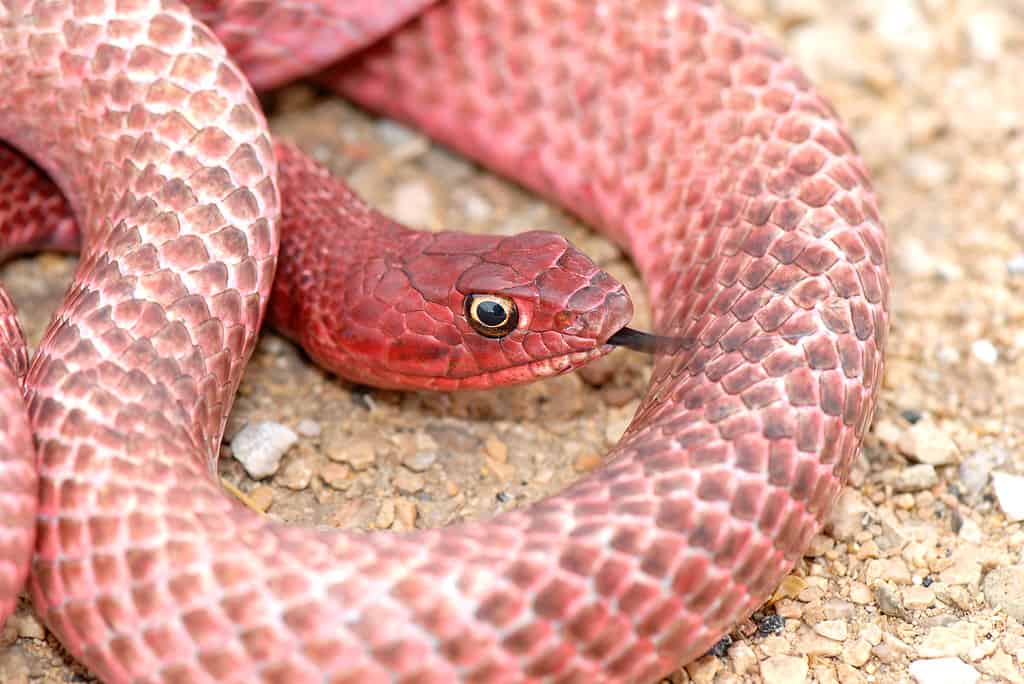
It isn’t odd for some snake species to have different colorations. Take this coachwhip, for instance, which is more pink than tan.
©Rusty Dodson/iStock via Getty Images
Western Coachwhips are long, slender snakes with very smooth, glossy scales. They are often brown or tan in color, but many of them have a black head. Their bodies are exceptionally slender, which is how they got their name.
They’re also whip-fast. Western coachwhips are exceptionally agile and fast-moving snakes. They’re often found in open environments like grasslands, deserts, and scrublands. However, they will hang around more open areas around the lake, as they are quite adaptable.
They consume just about anything they can catch, including small mammals and birds.
7. Texas Coral Snake
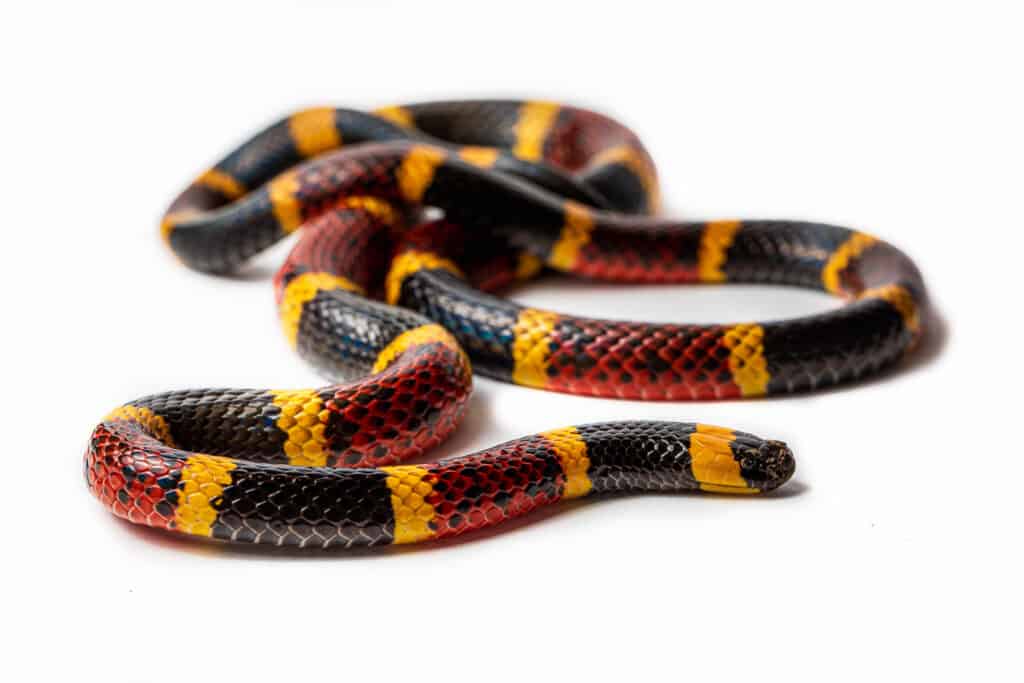
While they may not look nearly as intimidating as other venomous snakes, coral snakes are one of the most dangerous snakes in North America due to their very potent venom, which is a neurotoxin.
©Scott Delony/Shutterstock.com
Texas coral snakes are exceptionally venomous, though they are also strikingly beautiful. They feature a “striped” design with bands of red, yellow, and black. They are also relatively small, especially in comparison to other venomous snakes. However, their bright colors make them easy to identify and see.
That said, they tend to be extremely secretive and do not like being around people at all. Therefore, encounters with these snakes are extremely rare. While they are one of the most venomous snakes on the continent, they rarely bite humans.
8. Texas Garter Snakes
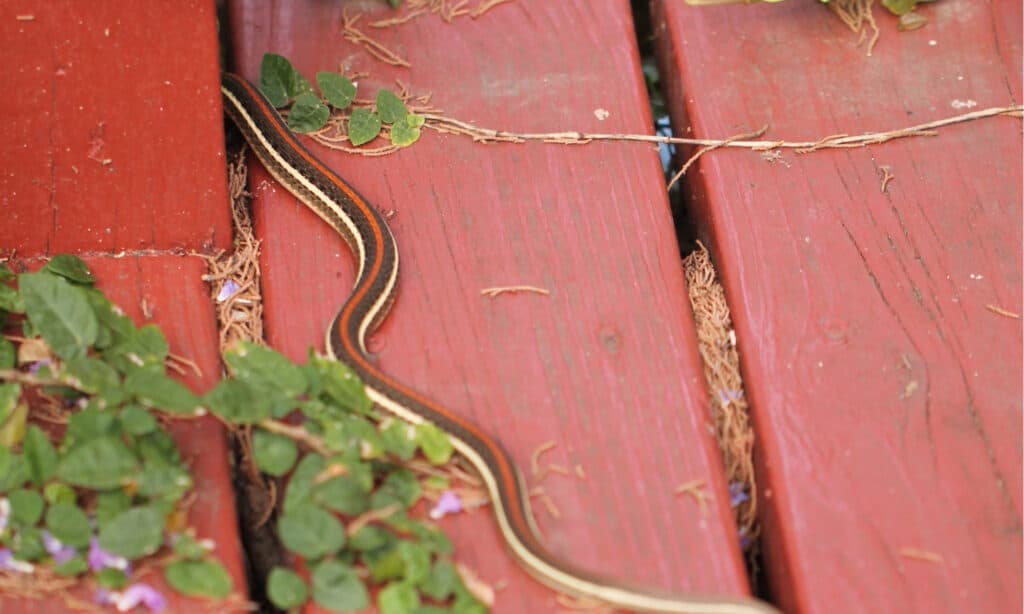
Due to their vertical stripes, these snakes are pretty easy to identify. Luckily, they’re completely harmless and often keep to themselves, avoiding people when possible.
©Cathleen Wake Gorbatenko/Shutterstock.com
Texas Garter Snakes are non-venomous and feature slender bodies with three distinct light-colored stripes running down their backs, often set against a darker background. Their coloration can vary substantially from area to area, making them a bit harder to identify.
These snakes are commonly found near water sources, like ponds and streams. Therefore, it isn’t odd to see them around any lake you visit in their natural range.
While they aren’t technically water snakes, they do feed primarily on aquatic prey, like fish and frogs.
9. Texas Brown Snake
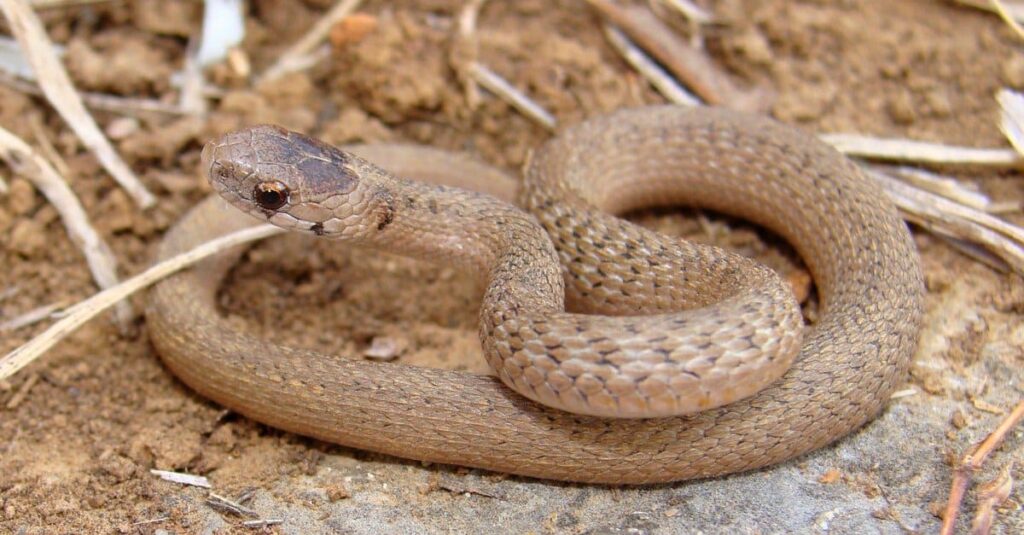
Texas brown snakes can look somewhat like copperheads due to their coloration. However, they don’t have any pattern on their back, and they are exceptionally small. They also have round pupils — not slitted like a Copperhead.
©Matt Jeppson/Shutterstock.com
Texas brown snakes are incredibly small, non-venomous snakes characterized by their slender bodies and brownish-gray coloration. Usually, they have a light stripe that runs along their back, which makes them pretty easy to identify.
It’s common to find these snakes in wooded areas and gardens. They’re pretty adaptable and feed primarily on invertebrates like slugs and worms, so they can live almost anywhere.
You may spot them around the lake. However, they’re so incredibly small that you may not even know if it’s right under your feet!
10. Broad-banded Water Snake
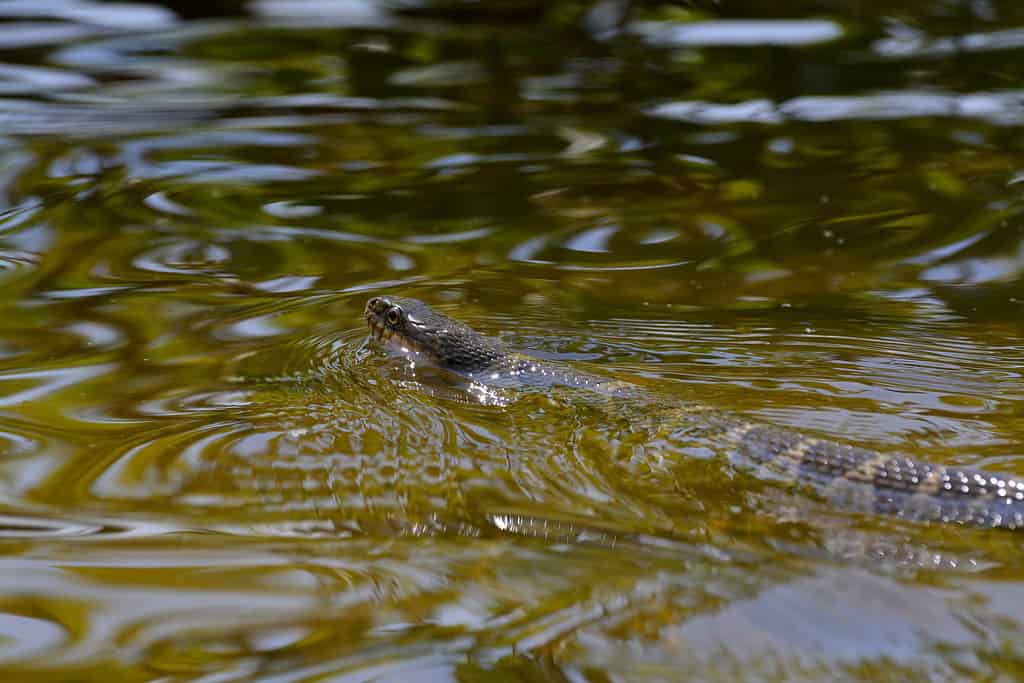
Banded water snakes are one of the few true watersnakes you might find in this lake. They may look similar to a cottonmouth, but they are often more black than copper.
©Lincoln Griffith/iStock via Getty Images
These water snakes are non-venomous. However, they are often mistaken for venomous water moccasins due to their similar appearance. They usually have dark bands or blotches with some sort of lighter background. (Which, honestly, makes them look very similar to a cottonmouth.)
As their name implies, they are frequently found near water bodies, such as Lake Buchanan, where they feed on fish, amphibians, and aquatic prey.
Other Animals Found in and Around Lake Buchanan
Lake Buchanan is also teeming with other wildlife beyond just snakes. Now that you’ve learned about snakes you might encounter at Lake Buchanan, let’s take a look at what other animals you may spot, too.
Birds
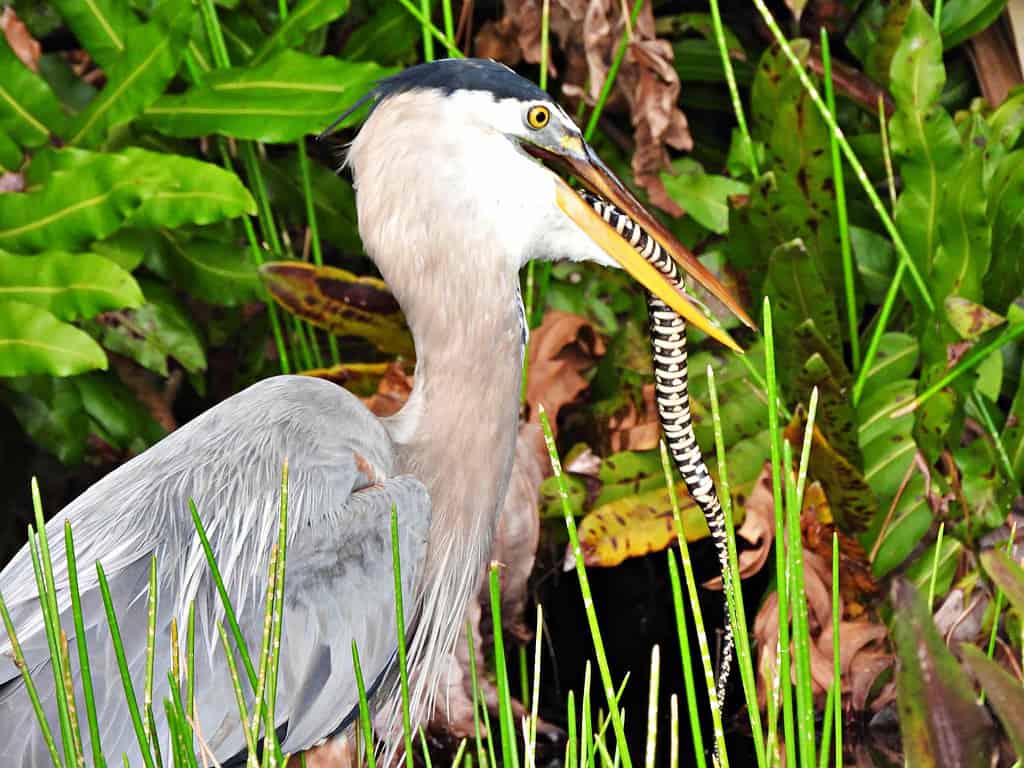
Great blue herons prey on snakes of all sorts around the lake, though they are not known to go after venomous ones.
©passion4nature/iStock via Getty Images
Lake Buchanan is a pretty popular spot for birdwatchers. It has a wide variety of avian species that you can watch for while on the lake. While little songbirds are very common, you may also see larger species, like bald eagles, ospreys, great blue herons, egrets, cormorants, and numerous waterfowl.
This lake serves as an important habitat for migratory birds of all sorts, making it an exceptionally popular spot for bird enthusiasts every year. You may even glimpse some of the rarer species that come through the area.
Fish
As you might imagine, there are tons of fish in this lake. It’s known for its excellent fishing opportunities, largely due to its population of fish. You’ll often see anglers targeting striped bass, white bass, catfish, and sunfish.
Because of its popularity, many anglers come here to target trophy-sized fish. It isn’t uncommon for massive fish to come out of the lake, after all. However, you may also see some recreational anglers simply enjoying their time on the water.
Mammals
There are tons of different mammals in the area around the lake. You may spot some big ones, like white-tailed deer, as well as smaller mammals, like raccoons, armadillos, and foxes. There aren’t any significantly dangerous animals in the area, though.
Additionally, the region is known for its bat colonies, particularly the Mexican free-tailed bats that inhabit caves and cliffs in the area. Many of these bats are protected species and do not pose a threat to humans. However, it’s still important to keep your distance. Some can transmit diseases if you handle them extensively or are bitten.
Reptile and Amphibians
Besides the snakes we’ve already discussed, there are also tons of other reptiles and amphibians in and around the lake. You may spot a range of lizards, turtles, frogs, and toads. Often, these animals are pretty skittish, but they still make an appearance.
You may also spot a couple of rarer species, like Texas horned lizards. Many endangered species live around the lake, so it’s important to tread lightly.
Invertebrates
Invertebrates make up the bottom of the food chain. Therefore, tons of insects and other invertebrates are expected to be found around the lake. While these bugs can be annoying on a warm summer day, they are vital for the local ecosystem. They often play a critical role in pollination, as well as feeding other animals.
Of course, some insects are dangerous. Mosquitos can transmit diseases, and they tend to be most plentiful around still-water sources (like lakes). Therefore, it’s important to use bug spray and take other precautions to avoid getting bit as much as possible.
Aquatic Life
On top of the fish and other aquatic animals that spend time in the lake, Lake Buchanan hosts a variety of aquatic life. You’ll find animals like crayfish, freshwater mussels, and other aquatic invertebrates. Many of these make up the bottom of the food pyramid for aquatic life, so they are essential to the environment.
Plant Life
Of course, there are various plant species in and around the lake, too. Native grasses, wildflowers, and shrubs are extremely common. Cypress trees and oak trees also bloom around the lake, providing habitats for many kinds of animals.
Plant life is essential to the ecosystem. Therefore, it’s very important that you treat plants with the same respect that you provide to the animals around the lake.
There are also many aquatic plants within the lake itself. Water lilies and submerged vegetation provide food and shelter for aquatic life. While you may not be able to see them, they contribute to the wealth of biodiversity in the region.
What to Do if You Encounter Snakes
Encountering a snake near Lake Buchanan, or in any natural habitat, can be an interesting experience, but it’s essential to handle the situation with caution. Because so many snakes live in the area, it isn’t all that uncommon to encounter one. Often, there is no reason to fret.
Most snakes will avoid humans if they can. Rattlesnakes have a whole warning system just to keep humans and other animals away! Therefore, seeing a snake does not mean you’re in harm’s way. Stay calm and give the snake plenty of room.
If you’re near the snake, back away slowly. Keep an eye on the snake at all times, and don’t make any sudden movements. Most snakes don’t want conflict. You just have to communicate that you aren’t there to harm them.
Once you’re at a safe distance, remain at a safe distance. The distance will depend on the snake’s species, but it’s best to stay at least several feet away. Snakes can strike a distance roughly equivalent to their body length.
Do not make any attempt to handle or kill the snake. While it may make sense to kill a venomous snake, they are an important part of the ecosystem. Plus, striking the snake will make it strike back, increasing the odds of you getting bit.
Misidentifying a snake is easy, as well. Many non-venomous snakes are mistakenly killed each year.
If you’re in a public area near the lake, alert others to the snake’s presence, especially if there are children or pets nearby. Encourage them to follow the same safety guidelines. While the snake will likely leave the area as soon as it feels safe, that doesn’t mean you should return to the same spot.
If you encounter a venomous snake in a public area or near a popular recreational spot at Lake Buchanan, consider reporting it to the local authorities or park rangers. They may need to take action to ensure public safety. Sometimes, venomous snakes are moved to other, more rural areas of the lake.
Always avoid walking through tall grass or dense vegetation. Many snakes will hide here, and they may be difficult to spot, leading to accidental bites.
If you plan to spend a lot of time around Lake Buchanan or other natural areas, it’s a good idea to educate yourself about the snake species in the region. Knowing which snakes are venomous and how to identify them can be beneficial.
The photo featured at the top of this post is © Clint Lockwood/Shutterstock.com
Discover the "Monster" Snake 5X Bigger than an Anaconda
Every day A-Z Animals sends out some of the most incredible facts in the world from our free newsletter. Want to discover the 10 most beautiful snakes in the world, a "snake island" where you're never more than 3 feet from danger, or a "monster" snake 5X larger than an anaconda? Then sign up right now and you'll start receiving our daily newsletter absolutely free.
Thank you for reading! Have some feedback for us? Contact the AZ Animals editorial team.






